
Witness to a Sky Burial in Tibet
Sky burial in Tibet is extremely mysterious for most people because strangers are usually not allowed to watch sky burial ceremonies in Tibet. So this mysterious custom in Tibet intrigues more and more people's curiosity. If you are lucky to get a chance to witness a sky burial in Tibet, please respect local custom. Do not get close to the sky burial site, take photos and ask any questions on site. Just stay quiet.
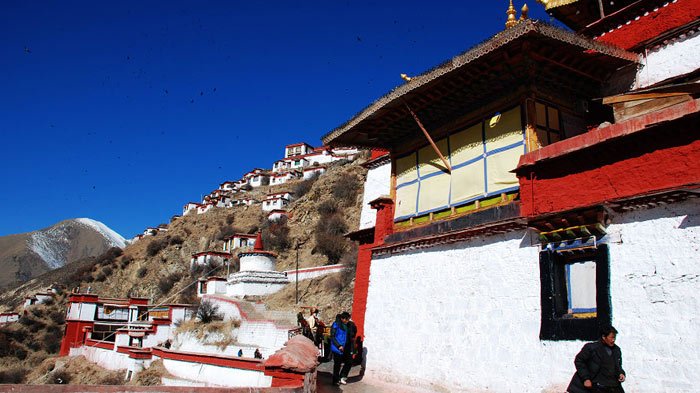 Drigung Monastery
Drigung Monastery
On the steps in front of Drigung Monastery, a dozen monks chant. Before them on the courtyard flagstones lies a body, wrapped in white cloth, which was carried in on a stretcher an hour ago. The monks are praying for a spirit that was once present here, but now is emancipated from its former home. It is the third such visitor today, for Drigung Gonpa has a profitable but gruesome specialty: disposal of the dead.
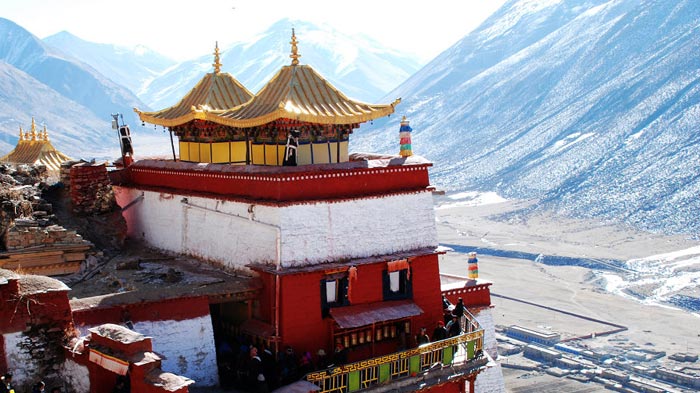 Overlooking from Drigung Monastery
Overlooking from Drigung Monastery
My team and I arrived here last night, after a long day's drive from Lhasa to Meldor Gungkar County in Central Tibet. Drigung monastery is on a steep hill, overlooking our camp. Above the religious complex is a site for "sky burial," a term meaning disposal of a corpse by allowing it to be devoured by birds. The birds, which are summoned by incense and revered by Tibetans, cast their droppings on the high peaks. Sky-burial is practiced all over the plateau, but Drigung is one of the three most famous and auspicious sites.
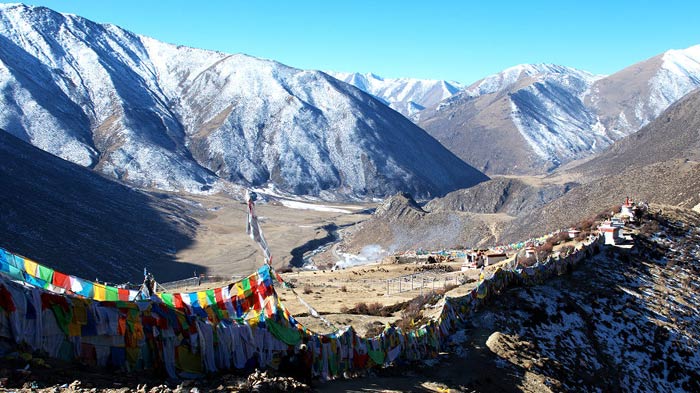 Sky burial site
Sky burial site
After the chanting is over, we walk up a well-trodden path to a high ridge, keeping a respectful distance behind the funeral party, which has come all the way from Lhasa to discharge this final duty to their departed friend. The charnel ground, or durtro, consists of a large fenced meadow with a couple of temples and a large stone circle of stones at one end where the ceremony takes place. Prayer flags hang from numerous chortens, and scent of smoldering juniper purifies the air. Vultures circle overhead, and many more are clustered on the grass, a few meters from the funeral bier.
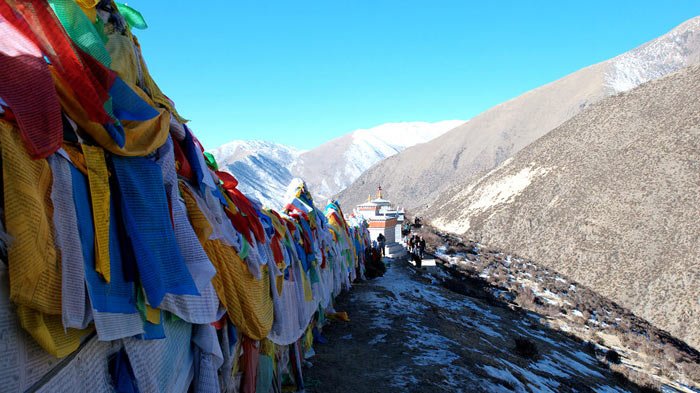 Prayer flags are hung around Drigung Monastery.
Prayer flags are hung around Drigung Monastery.
Tibetans practice several forms of disposal of the dead, but sky burial (celestial funeral)is the most common method and indeed a very practical one in a land where fuel is scarce and the earth is often too hard to dig. For me, this is an extraordinary opportunity, for these days not one visitor in five hundred is privileged to witness the ceremony I'm about to see. But I am apprehensive, too, wondering how I will stomach the sight of death.
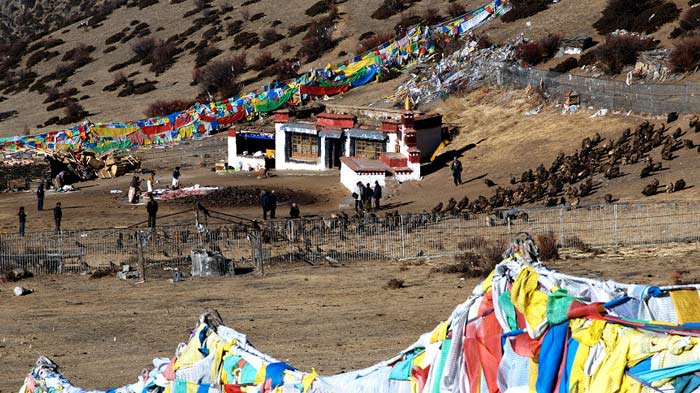 Preparing for sky burial
Preparing for sky burial
Men in long white aprons come out, and unwrap the corpse, which is naked, stiff, and swollen. The men hold huge cleavers, which are in a few strokes whetted to razor sharpness on nearby rocks. The bright sun and clear blue sky diffuse somewhat my ominous feeling. The coroners themselves, are not heavy or ceremonial, but completely businesslike as they chat amongst themselves, and prepare to start.
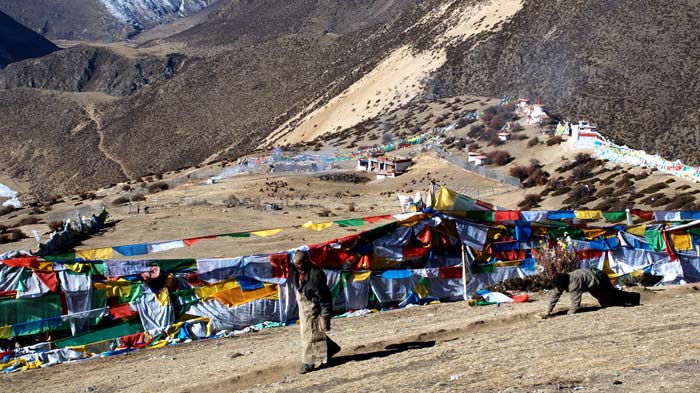 Sincere pilgrims are prostrating around sky burial site.
Sincere pilgrims are prostrating around sky burial site.
Tibetans believe that, more important than the body, is the spirit of the deceased. Following death, the body should not be touched for three days, except possibly at the crown of the head, through which the consciousness, or namshe, exits. Lamas guide the spirit in a series of prayers that last for seven weeks, as the person makes their way through the bardo—intermediate states that precede rebirth.
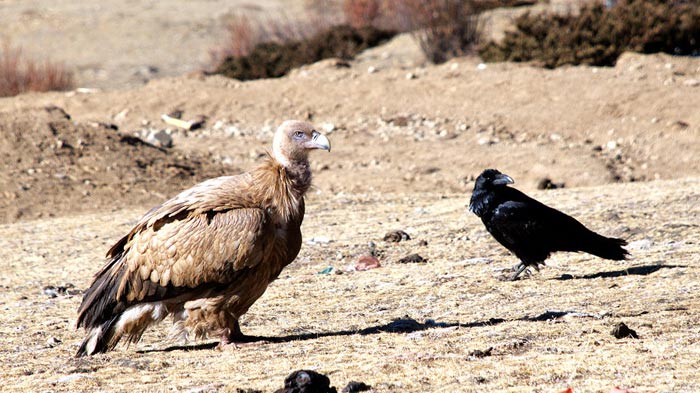 Vultures are waiting for the flesh.
Vultures are waiting for the flesh.
As the first cut is made, the vultures crowd closer; but three men with long sticks wave them away. Within a few minutes the dead man's organs are removed and set aside for later, separate disposal. The vultures try to move in and are prevented by waving sticks and shouts. Then, the cutters give a signal and the men all simultaneously fall back. The flock rushes in, covering the body completely, their heads disappearing as they bend down to tear away bits of flesh. They are enormous birds, with wings spanning more than 2 meters, top-feathers of dirty white, and huge gray-brown backs. Their heads are virtually featherless, so as not to impede the bird when reaching into a body to feed.
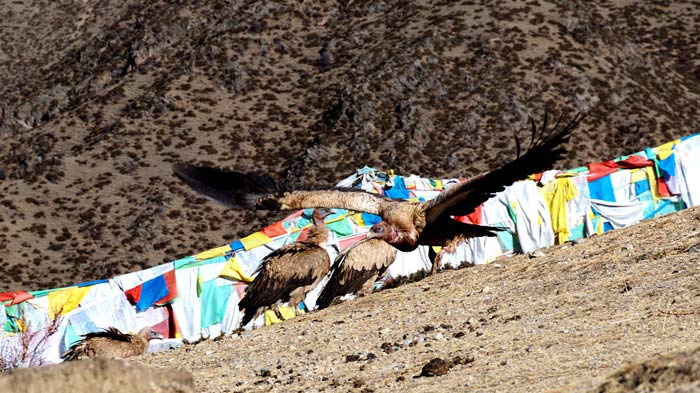 Vultures are flying towards sky burial site.
Vultures are flying towards sky burial site.
For thirteen minutes the vultures are in a feeding frenzy. The only sound is tearing flesh and chittering as they compete for the best bits. The birds are gradually sated, and some take to the air, their huge wings sounding like steam locomotives as they flap overhead. Now the men pull out what remains of the corpse—only a bloody skeleton—and shoo away the remaining birds. They take out huge mallets, and set to work pounding the bones. The men talk while they work, even laughing sometimes, for according to Tibetan belief the mortal remains are merely an empty vessel. The dead man's spirit is gone, its fate to be decided by karma accumulated through all past lives.
 After funeral ceremony, relatives and friends went back home.
After funeral ceremony, relatives and friends went back home.
The bones are soon reduced to splinters, mixed with barley flour and then thrown to crows and hawks, who have been waiting their turn. Remaining vultures grab slabs of softened gristle and greedily devour them. Half an hour later, the body has completely disappeared. The men leave also, their day's work finished. Soon, the hilltop is restored to serenity. I think of the man whose flesh is now soaring over the mountains, and decide that, if I happen to die on the high plateau, I wouldn't mind following him.

With exceptional passion and outstanding leadership, Mrs. Catherine has dedicated herself to Tibet inbound tourism and China tour for 15 years. As one of the handful females who see great potential of Chinese inbound tourism, Catherine has made great contribution to promoting Tibet tourism and enhancing the employment of Tibetans and prosperity of local Tibetan community.
Over the years, she travelled overseas with Tibet Tourism Bureau many times to promote Tibet tourism. Currently, Catherine works as the marketing director of Tibet Vista, an opinion leader behind the whole team of Tibet Vista.


.jpg)




0 Comment ON "Witness to a Sky Burial in Tibet"